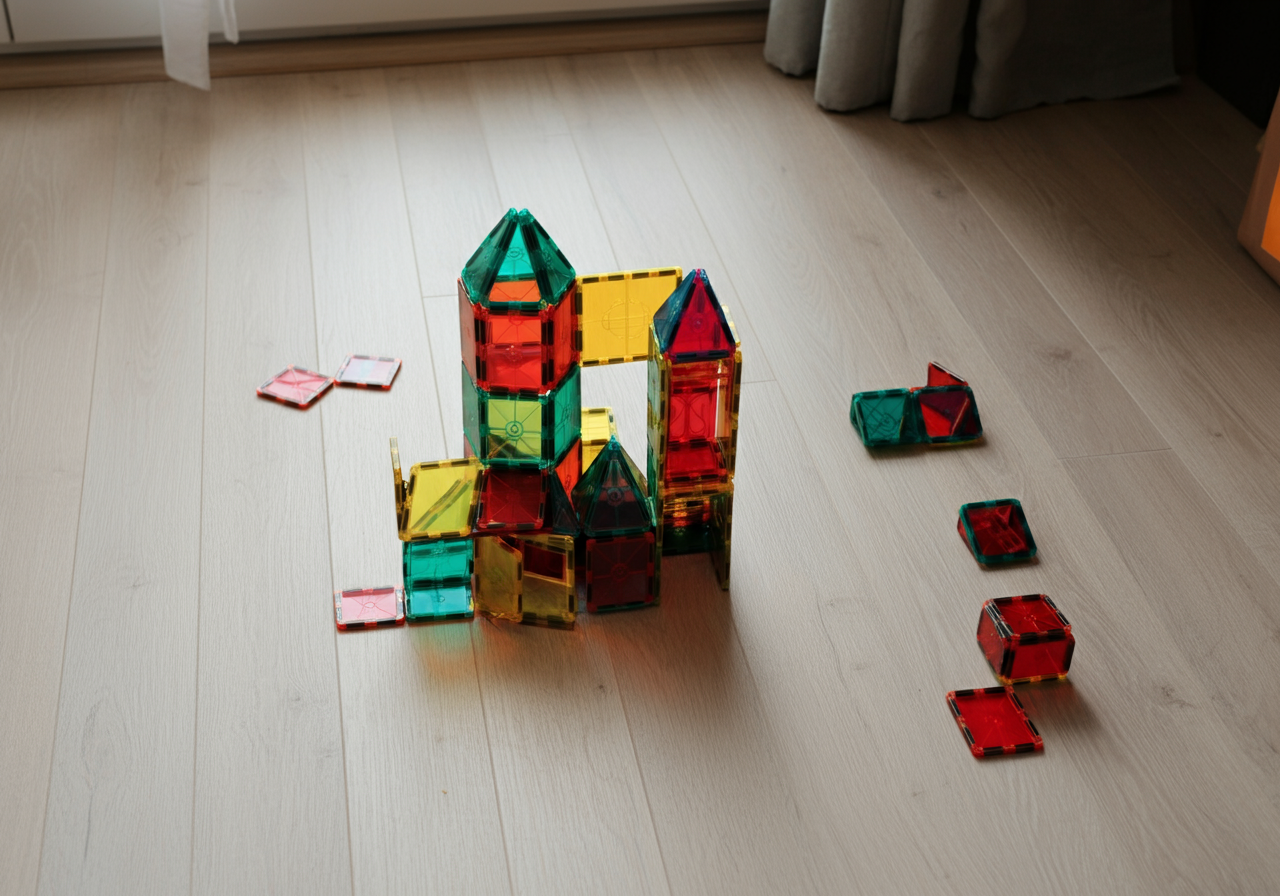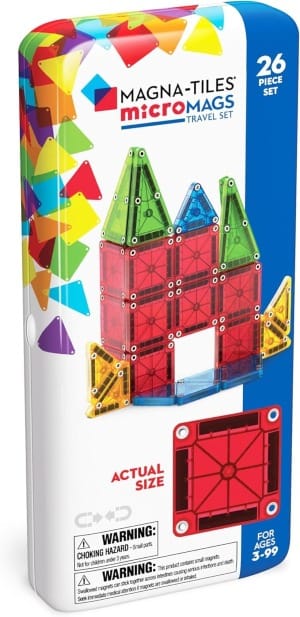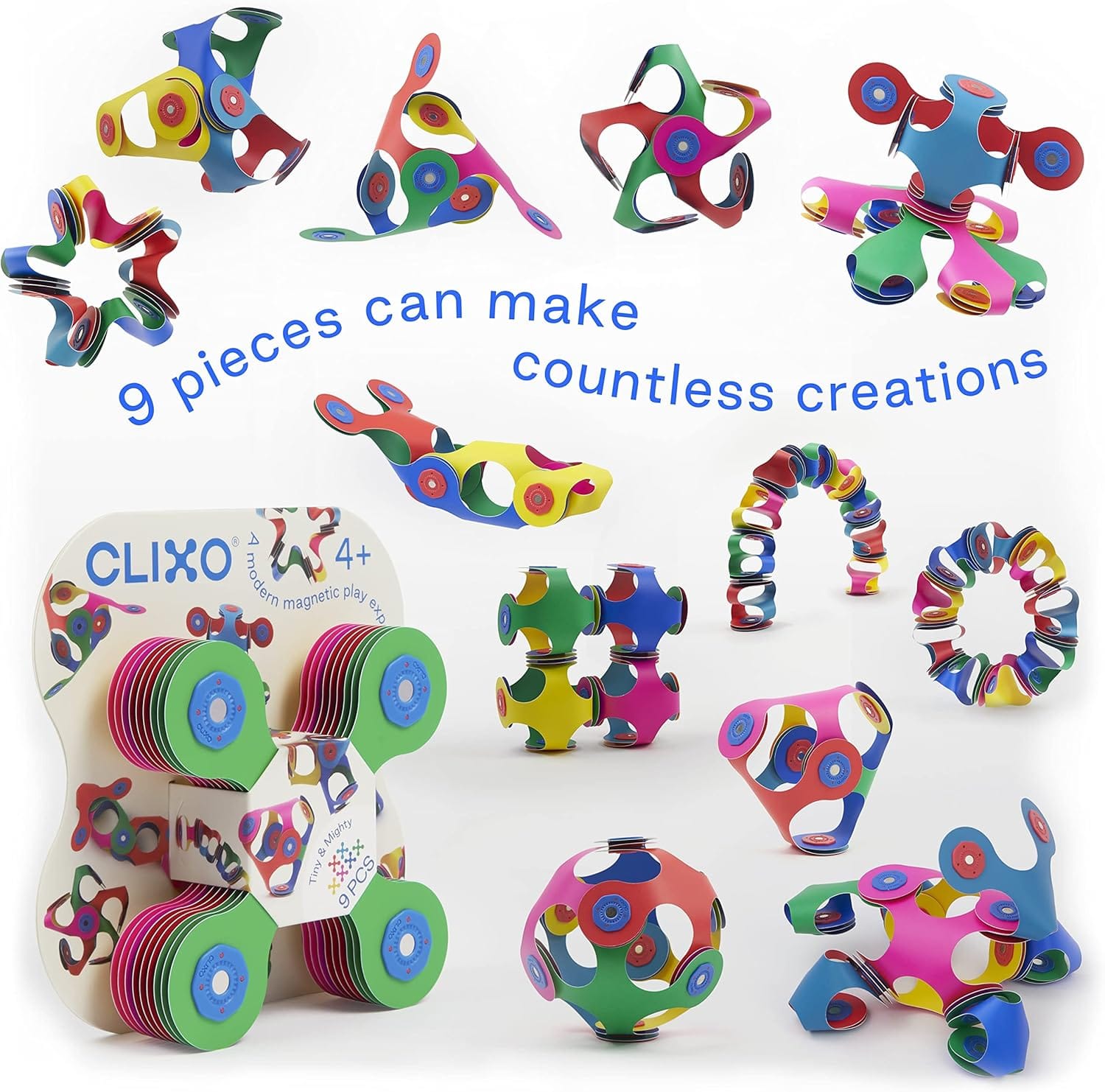The Stories Inside Magnetic Tiles
Roy's not just building with magnetic tiles - he's world-making. From alligator airports to houses where every friend has boat parking, these constructions reveal the stories children tell to make sense of their world.

Aren't buildings always stories anyway?
Roy dumps the magnetic tiles onto the lounge room floor with the (too loud for my over stimulated ears) clattering sound that makes everyone look up. He's not just building - he's world-making.
A recent creation was an "alligator airport" - a complex structure with opening doors, a plane housed inside, and a long track where marbles can run down into a kind of runway drawbridge. The alligator element came from Lyle, Lyle, Crocodile playing in the background while he built.
I love watching these stories being built in real time, influenced by whatever's available: shapes, sounds, and pure imagination.
The Travel Discovery
Roy's skill with magnetic tiles revealed itself most clearly when we traveled with a small set of mini tiles earlier this year. Away from home for an extended period, he spent hours constructing versions of his closest friends' houses.
Each house was different, but they all shared one feature: boat parking. Every friend, in Roy's tile world, owned a boat and needed a dedicated place to keep it. I watched him carefully select colors, place shapes with precision I hadn't seen before, and narrate who lived where.
"This is Thomas's house, and this is where he keeps his boat," he'd explain, adding a blue rectangular section adjacent to each structure. The emotional intelligence embedded in this play was remarkable - he was processing separation by creating a world where his friends had everything they needed, including the boats that might bring them together.
Beyond the Building
Magnetic tiles get praised for their engineering potential - and rightly so. Children learn about shapes, stability, and spatial relationships through play. But there's another layer happening here that's equally valuable: narrative construction.
Each building tells a story. The airport with creature-inspired architecture. The houses where friends can visit by boat. The structures that respond to whatever's playing in the background, weaving screen content into physical play.
Games That Grow With the Tiles
For Younger Builders (3-5)
- Create houses for different animals, discussing what each creature needs
- Build color patterns and tell stories about rainbow paths
- Make simple enclosures and act out scenarios with toy figures
For School-Age Architects (6-8)
- Challenge: Build flag representations of different countries, then share what you know about each place
- Create mirror buildings - construct something, then challenge someone else to build its reflection
- Design structures that solve problems: a bridge for toy cars, a garage that protects vehicles from weather
For Everyone
- Collaborative storytelling: One person builds a room, explains who lives there, then the next person adds onto the story
- Time period building: Create structures from different eras, discuss how homes have changed
- Community planning: Build an entire neighborhood and populate it with stories
The Investment Question
Quality magnetic tiles aren't cheap, but they justify their cost through longevity and open-ended play. Unlike toys with specific functions, magnetic tiles adapt to changing interests and developmental stages.
For Travel: The mini-sized magnetic tiles proved invaluable during extended travel. They pack small, provide hours of quiet entertainment, and don't require additional setup. Roy's precision with color and shape selection became apparent when working with a limited set - every piece placement was deliberate and meaningful.
For Home: Larger collections enable ambitious projects like the alligator airport but can require a commitment to availability of sufficient playspace.
The tiles will likely become more complex engineering projects as Roy grows, then eventually be regifted to younger children who will find their own stories inside the shapes. Or these may be such a favourite that they'll make their way into the 'to be retained for the kids' kids' collection. The way that collection is growing though, I'm starting to wonder if we'll need a dedicated storage unit.
What This Reveals
Watching a child build worlds with magnetic tiles reveals their internal landscape. The stories they tell through structures reflect their concerns, interests, and understanding of how the world works.
During our time away from home, Roy consistently built houses with boat parking for all his friends - processing separation by ensuring everyone had what they needed for connection. Back in familiar space, his constructions weave together whatever's available, like airport architecture influenced by friendly crocodiles and, this morning, a collaboration with his older brother - the 'party room racetrack' that features a swinging gate that can divide the track to make it competitive or open it up for the balls to roll down together.
Children's building play is rarely about the tiles themselves. It's about using physical materials to work through emotional and intellectual puzzles.
The Educational Disguise
These games incorporate learning into play so effectively that you might not notice it happening. Geography through flag-building. Physics through structural challenges. Social studies through community design. Emotional processing through friend-house creation.
But the stories remain the heart of it. Without narrative, the tiles are just colorful shapes. With stories, they become worlds where friends have boats and airports accommodate alligators.
Why This Matters
In a world full of predetermined play experiences, magnetic tiles offer the gift of creative control. Children decide what to build, how to build it, and what stories to tell through their constructions.
The stories that emerge aren't scripted by adults or programmed by designers. They're authored by young minds making sense of the world through play. That's worth the investment in good tiles that will last through years as well as the table or floor space they require.
Looking for where to buy magnetic tiles?
You can find them in the toy section at most big department stores (e.g., Target, Kmart, Big W) and most will mix and match quite neatly if you decide to combine brands. However, our brand recommendations both for quality and variety in the kits are Magna-Tiles and Connectix. Magna-Tiles in particular, has the micromags sets that, as well as increasing the flexibility of your build options, make an ideal travel toy.
Something else I love about magnetic tiles as a toy is that there are many other 'genres' of magnetic toys to combine them with. We have a number of other magnetic toys, most notably some Clixo (a kind of magnetic origami hybrid) and I'm anticipating we may see some wild designs in the future as the different genres start being mixed more and more.

